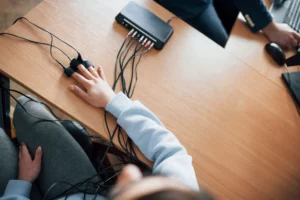Polygraph testing has long been controversial, with questions around its validity and accuracy. Traditionally done in-person, polygraph tests are now increasingly being offered online. But are these remote polygraph tests, taken unsupervised from home, equally credible?
What exactly is a polygraph test?

A polygraph, popularly referred to as a lie detector test, aims to assess truthfulness by measuring and recording several physiological indicators such as blood pressure, pulse, respiration, and skin conductivity while asking a series of questions. The belief is that lying causes measurable physical and emotional reactions.
Polygraph examiners then analyze the results of the test to determine if deception is indicated. Proponents argue polygraphs provide 90-95% accuracy, while critics dispute those claims and argue 50% accuracy or lower in many cases.
The rise of online polygraph testing
In the past decade, dozens of websites have started offering online lie detector services. These provide kits to use at home, including devices to capture physiological data that get analyzed through automated scoring systems. The convenience and privacy factor has fueled significant growth.
Online tests are now being used for:
- Pre-employment screening
- Marital infidelity investigations
- Online dating background checks
- Monitoring convicted sex offenders
- Student honor code violations
- Insurance claim investigations
Proponents argue online tests save money and time while providing more privacy. However, serious concerns exist around validity.
Factors impacting accuracy of online testing

Unfortunately, taking a polygraph test unsupervised introduces many variables that complicate reliability.
1. Lack of examiner interaction
Traditional polygraph tests rely heavily on a trained examiner managing the entire process and procedure, as well as analyzing results. Nuances like question phrasing, physical observations, and conversational dynamics provide context that automated systems lack.
Without a skilled examiner, online polygraphs become far less standardized. Examinees can potentially manipulate the situation or alter data undetected.
2. Possibility of outside interference
When unsupervised, outside interference with the polygraph equipment or the examinee’s physiology cannot be ruled out. There are techniques people can use to intentionally alter measurements such as pressing toes to the floor to change blood pressure.
Without video monitoring, these actions can mislead computerized scoring.
3. Inability to ensure proper equipment setup
Much can go wrong in do-it-yourself equipment setup, like improperly placed sensors resulting in inaccurate data collection. Transmitting the data accurately to servers for scoring presents another issue.
Traditional lab-based tests verify correct sensor usage and transmission. Lacking oversight opens major accuracy gaps.
4. Automated polygraph scoring limitations
Even with accurate data collection, computerized scoring lacks the sophistication of professional examiners who consider multiple subtle factors.
Automated systems are prone to oversimplification, like categorizing results as deceptive/not-deceptive based on measurements passing a set threshold. Misclassification rates as high as 40% have been found.
5. Differences in testing environments
Taking an online polygraph test at home provides a completely different environment than a controlled lab setting. The comfort of home may induce false results in either direction.
Environmental distractions, lack of formality, and reduced examinee anxiety could all contribute to unreliable data.
6. Lack of deterrence
In-person testing creates an atmosphere conducive to eliciting admissions due to the formal setting and examiner interactions. This crucial deterrence effect is largely lost remotely.
Those inclined to deception may find it easier to lie without accountability pressure, skewing results.
legal issues

Beyond accuracy concerns, online polygraph testing raises legislative issues regarding privacy, fairness, and misuse:
- Lack of regulation around how physiological data is stored, transmitted, or accessed
- Potential discrimination if used inconsistently across candidates -Possibility of coercion or unauthorized use, especially in marriage/dating contexts
- Results used improperly as infallible instead of with healthy skepticism
The American Polygraph Association cautions against reliance on unsupervised testing for these reasons. However, the ease and demand make it likely online testing will continue growing, necessitating consumer education.
Best practices for online testing
While uncertainty remains, accuracy and fairness could be improved by:
- Having an examiner involved via video call throughout the entirety of the online test.
- Using precise written protocols for sensor setup, questions asked, timing of measurements etc.
- Conducting tests in a formal, distraction-free environment under video monitoring.
- Automated scoring algorithms avoiding binary deception labels in favor of probability-based results.
- Ensuring examinees understand the limitations around use.
- Complete examiner training focused on remote polygraphy instead of traditional techniques.
Eye-tracking for lie detection
A newer approach to remote polygraphy involves tracking eye movements to detect deception. Companies offer online eye-tracking tests pitched as cutting-edge “lie detectors”.
The premise is that lying produces measurable differences in patterns like pupil dilation, blink rate, and gaze direction. Algorithms analyze the eye metrics for signs of cognitive stress assumed to signal dishonesty.
Proponents claim eye-tracking is less invasive than traditional sensors and aim for it to one day augment or replace polygraph testing. But its validity remains highly debated.
Claimed advantages

Eye-tracking test providers tout advantages like:
- Less cumbersome than traditional polygraph sensors
- Harder for subjects to consciously manipulate eye behaviors
- Machine learning can detect subtle patterns imperceptible to humans
- Remote testing capability with only a computer webcam required
They argue their tests identify deception with over 85% accuracy under lab conditions.
Limitations and concerns
However, experts raise numerous limitations:
- Lack of real-world testing and peer-reviewed research verifying remote accuracy claims
- No standardized procedures or protocols in place
- Susceptibility to environmental and physiological influences on eye metrics
- Absence of well-defined baseline eye behavior patterns for comparison
- Possibility of automated scoring mistakes due to variability among individuals
- Ethical issues like privacy, coercion, and misinterpretation of results
More research and oversight are needed before eye-tracking gains credibility. While the concept offers promise, present capabilities appear premature.
Skepticism remains high around marketing claims of webcam eye-tracking tests as reliable “lie detectors”. But their evolution bears watching.
The future of online polygraph testing
While skepticism is warranted today, technology and industry standards continue advancing. What might the future look like?
Remote examiner interaction
As video conferencing improves, remote examiners could replicate more of the in-person experience. High definition video would allow them to closely monitor for outside interference while observing the examinee.
Examiners could also build rapport, explain the process, and phrase questions tailored to the individual – important human elements.
Enhanced sensor technology and AI
More sophisticated sensors, computer vision and artificial intelligence could improve remote data collection accuracy. Systems could potentially:
- Use visual feeds to ensure proper sensor placement and usage
- Notice and adjust for environmental factors like temperature and lighting
- Apply machine learning to score results based on datasets from thousands of past tests
- Detect efforts to fool the system like intentionally altering breathing
Security and process standardization
Stronger security protocols around video feeds, data transmission, automated controls, etc. would help prevent tampering.
Strict standardization of protocols for sensor placement, environment, questions asked and more would reduce variability.
Hybrid approach
A hybrid approach combining automated scoring with human examiner interpretation could capitalize on strengths of each. The technology provides efficiency while the examiner applies nuance.
Potential future uses

With improvements, more cases may benefit from online testing:
- Remote testing could expand access for those in rural areas or with disabilities.
- Fast results at low cost could enable periodic retesting of those in roles requiring high levels of trust.
- Parole boards could efficiently test offenders more frequently when considering release eligibility.
- Computerized systems could flag improbable results for human follow-up, saving examiner time.
- AI assistants could offer examiners feedback on accuracy of interpretations, similar to radiologists.
Societal impacts to consider
As adoption increases, we must consider potential impacts like:
- Minimizing collection and retention of personal data from tests
- Preventing misuse of results by employers, insurers, government agencies
- Ensuring fairness and avoiding embedded biases, especially with AI systems
- Protecting vulnerable populations like victims of abuse from coerced testing
- Providing transparency around algorithms used for scoring
With care, online polygraph testing may find the right niche – where convenience or privacy outweighs the need for maximum certainty. But caution is still advised. For now, for many high-stakes usages, in-person testing remains the gold standard. Though imperfect, on-site expertise, observation and control provide greater credibility over automated remote tests.
So are online polygraph tests accurate and reliable? In limited applications, with supervision and care, they may be “good enough”. But for many critical needs, skepticism remains warranted due to factors undermining validity, morality and oversight. As gadgetry evolves, their appropriate role should become clearer.

